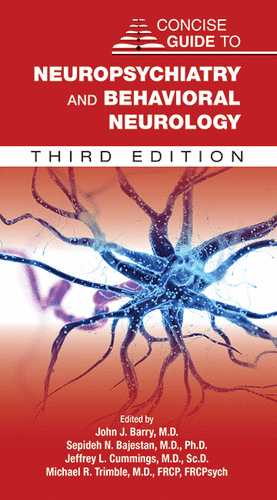Concise Guide to Neuropsychiatry and Behavioral Neurology, Third Edition

edited by John J. Barry, Sepideh Bajestan, Jeffrey L. Cummings, and Michael R. Trimble; Washington, D.C., American Psychiatric Association Publishing, 2023, 416 pages.
Few who have read the extensive histories and complex formulations of Behavioral Neurology & Neuropsychiatry would accuse subspecialists in this area of being concise. Yet, the editors of the Concise Guide to Neuropsychiatry and Behavioral Neurology have managed to tackle just such a task in producing the third edition of a classic book designed to “fit into a pocket virtually or physically.” The first edition, originally edited by Drs. Cummings and Trimble, who remain editors on this third edition, was released in 1995 with the goal of distilling the phenomenology, diagnoses, and clinical care of neuropsychiatric and neurobehavioral patients and making it available to students at all levels. There are a number of excellent traditional textbooks available but a dearth of small, easily accessible, and portable books in this space.
The third edition contains 23 chapters, a significant increase from the 15 chapters that constituted the second edition. Notable changes and additions include reconceptualizing and renaming the chapter on “Unexplained Neurological Symptoms” to the more timely “Functional Neurological Symptom Disorder,” which provides readers with an excellent brief overview of this common neurobehavioral condition; separating dementia and delirium into two distinct chapters, and separating stroke and brain tumors into two chapters; and adding chapters on alcohol and other substance use disorders, autism spectrum disorder, endocrine-related neuropsychiatric symptoms, limbic encephalitis, HIV neurocognitive disorder, and interventional neuropsychiatry.
The tables and figures are informative and well indexed. The tables are used to display a high density of information in little space, and they are used to great effect throughout the book.
The editors and authors clearly took great care to ensure that the changes in this edition were high yield. My clinical practice is focused heavily on dementia, and the updated chapter by Dr. Cummings is superb and reflects the current state of clinical practice. This chapter discusses the major causes of cognitive decline, addresses the utility of biofluid- and imaging-based biomarkers, and provides helpful treatment guidance in tabular format. The added chapters, such as those on autism spectrum disorder and limbic encephalitis, are strong additions to the book’s content that add value and provide real-world utility for clinicians at any stage of training. Given the broad scope, even those with board certification in Behavioral Neurology & Neuropsychiatry will find elements of this book useful.
Essentially all of the chapter names remain true to the original, although the content was significantly updated. This provides a sense of historical threads across editions, although some of the chapter titles are out of step with today’s preferred terminology. For example, the chapter on “Head Injury” might be better named “Traumatic Brain Injury,” but this minor quibble ends with the title. The chapter briefly touches on the most salient features that clinicians should think through in the evaluation and management of patients with traumatic brain injury.
All in all, this is a great update to an iconic series that provides a concise jumping-off point to understand a wide breadth of Behavioral Neurology & Neuropsychiatry. I can see myself recommending this to trainees and generalists wanting a brief but informative introduction to our field, and I am happy to have it among the contents of my black bag.


